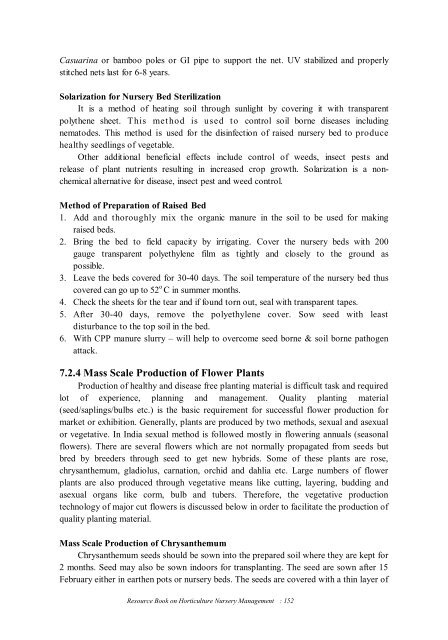Resource Book on Horticulture Nursery Management
Resource Book on Horticulture Nursery Management
Resource Book on Horticulture Nursery Management
Create successful ePaper yourself
Turn your PDF publications into a flip-book with our unique Google optimized e-Paper software.
Casuarina or bamboo poles or GI pipe to support the net. UV stabilized and properly<br />
stitched nets last for 6-8 years.<br />
Solarizati<strong>on</strong> for <strong>Nursery</strong> Bed Sterilizati<strong>on</strong><br />
It is a method of heating soil through sunlight by covering it with transparent<br />
polythene sheet. This method is used to c<strong>on</strong>trol soil borne diseases including<br />
nematodes. This method is used for the disinfecti<strong>on</strong> of raised nursery bed to produce<br />
healthy seedlings of vegetable.<br />
Other additi<strong>on</strong>al beneficial effects include c<strong>on</strong>trol of weeds, insect pests and<br />
release of plant nutrients resulting in increased crop growth. Solarizati<strong>on</strong> is a n<strong>on</strong>chemical<br />
alternative for disease, insect pest and weed c<strong>on</strong>trol.<br />
Method of Preparati<strong>on</strong> of Raised Bed<br />
1. Add and thoroughly mix the organic manure in the soil to be used for making<br />
raised beds.<br />
2. Bring the bed to field capacity by irrigating. Cover the nursery beds with 200<br />
gauge transparent polyethylene film as tightly and closely to the ground as<br />
possible.<br />
3. Leave the beds covered for 30-40 days. The soil temperature of the nursery bed thus<br />
covered can go up to 52 o C in summer m<strong>on</strong>ths.<br />
4. Check the sheets for the tear and if found torn out, seal with transparent tapes.<br />
5. After 30-40 days, remove the polyethylene cover. Sow seed with least<br />
disturbance to the top soil in the bed.<br />
6. With CPP manure slurry – will help to overcome seed borne & soil borne pathogen<br />
attack.<br />
7.2.4 Mass Scale Producti<strong>on</strong> of Flower Plants<br />
Producti<strong>on</strong> of healthy and disease free planting material is difficult task and required<br />
lot of experience, planning and management. Quality planting material<br />
(seed/saplings/bulbs etc.) is the basic requirement for successful flower producti<strong>on</strong> for<br />
market or exhibiti<strong>on</strong>. Generally, plants are produced by two methods, sexual and asexual<br />
or vegetative. In India sexual method is followed mostly in flowering annuals (seas<strong>on</strong>al<br />
flowers). There are several flowers which are not normally propagated from seeds but<br />
bred by breeders through seed to get new hybrids. Some of these plants are rose,<br />
chrysanthemum, gladiolus, carnati<strong>on</strong>, orchid and dahlia etc. Large numbers of flower<br />
plants are also produced through vegetative means like cutting, layering, budding and<br />
asexual organs like corm, bulb and tubers. Therefore, the vegetative producti<strong>on</strong><br />
technology of major cut flowers is discussed below in order to facilitate the producti<strong>on</strong> of<br />
quality planting material.<br />
Mass Scale Producti<strong>on</strong> of Chrysanthemum<br />
Chrysanthemum seeds should be sown into the prepared soil where they are kept for<br />
2 m<strong>on</strong>ths. Seed may also be sown indoors for transplanting. The seed are sown after 15<br />
February either in earthen pots or nursery beds. The seeds are covered with a thin layer of<br />
<str<strong>on</strong>g>Resource</str<strong>on</strong>g> <str<strong>on</strong>g>Book</str<strong>on</strong>g> <strong>on</strong> <strong>Horticulture</strong> <strong>Nursery</strong> <strong>Management</strong> : 152











